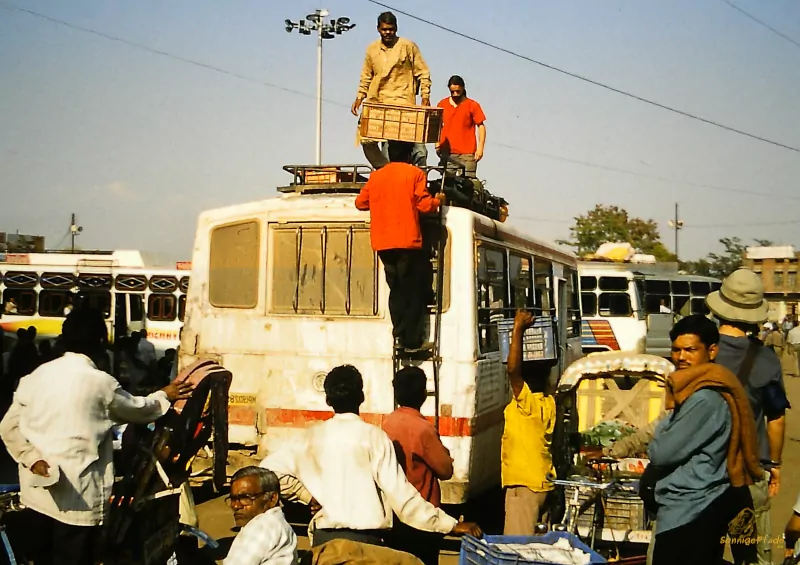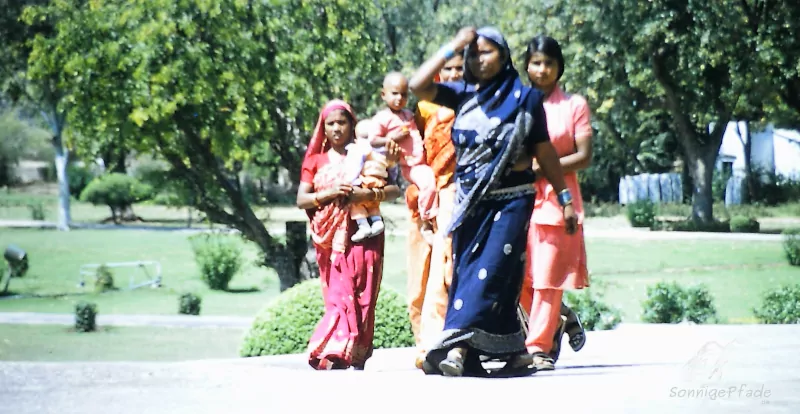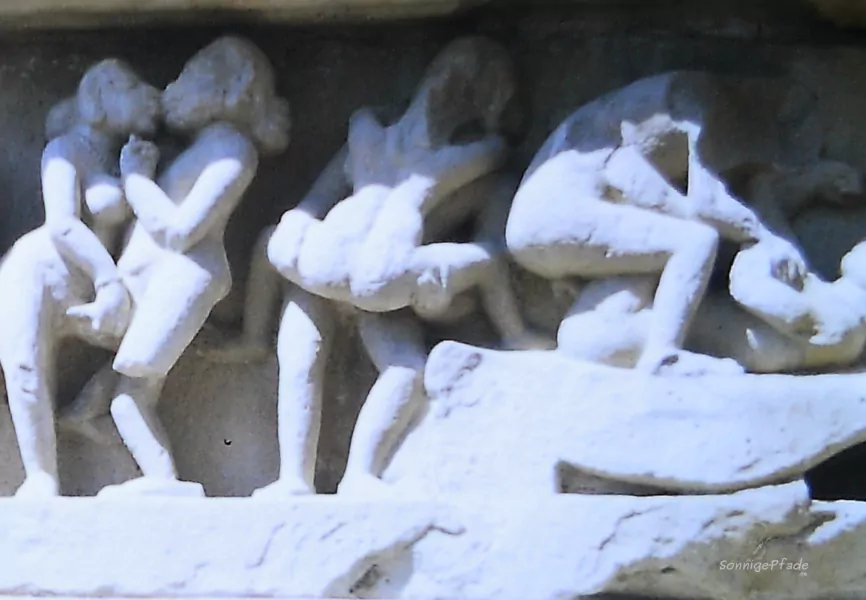
After a short night in the sleeper coach, we leave the Chapra Durg Sarnath Express in Satna. It is around seven in the morning and we stroll over to the nearby bus station. Life is just awakening there. To the next bus to Khajuraho, that takes a while. But that doesn’t matter, there is always something going on at bus stations in India. With a small breakfast, the hunt for a „black coffee“ and persistent observation of the hustle and bustle around us, the time passes.
first published in german under Reisegeschichten – travel stories


On this bus, once again larger luggage is loaded on the roof. I take over this best myself, so that everything is firmly lashed. Then it goes off in the direction of Khajuraho. Our place – once again the „place of honor“ in front left beside the driver. He tramples with his bathing shoes on the rusty pedals. Underneath you can see the dusty road through holes in the floor. But the horn works, that’s the most important thing. Properly loud, so the appropriate right of way – claim is demanded.
In Khajuraho, rickshaw drivers and hotel touts rush in on us. We decide once again for a – „Yogi Lodge“. After the experiences in Varanasi this is probably a good omen. Jokingly, after inspecting the room, we still demand that the shower head be cleaned and repaired as a condition of our booking. Of course, this does not happen. Most of the time it helps to unscrew the shower head and shower water out of the bare pipe. But for 70 Rupees in a reasonably clean room we do not complain. We can even get bicycles for little money.
In the evening we get in an audio and light show a first impression of the temple complexes and the history, with battle turmoil and radio play scenes in English.
In the morning we drive on a tip from our „hotel management“ to an old yogi nearby. Around us a beautiful garden full of fruits from bananas to papaya, guavas, pomegranates to mango etc. There we sit in a circle and talk a little about our „ordinary life“. It is not about Hatha – Yoga with all kinds of asanas, but about talking. The yogi tells us about the meaning of yoga, about the nonsense of religions, which all only want to make people dependent and have power over them, about the importance of taking care of oneself, of observing, of inner independence and freedom, of love and dependence and the relationship between mind and heart… He tells us he is 70 years old. To me he looks more like 50…. „Be like a flower… butterfly comes, butterfly goes…“
Khajuraho in the north of Madhya Pradesh is actually just a village. About 24,000 inhabitants in the village and the surrounding area are tiny by Indian standards. However, I noticed hotels of all major hotel groups from the bus, and the own airport behind them. This has its reason:
The temple – complexes of Khajuraho
In the year 1838 a British survey officer moved by order of his majesty through the land south of the Ganges – plain. In the jungle, overgrown with bushes and trees, he discovered ancient temples with thousands of small figures. These apparently depicted battle scenes, but also everyday life. As he looked closer at the friezes, disturbing depictions suddenly caught his eye – males and females in rather explicit poses, some of them several at a time, pleasuring each other, animals in between, and heavy things….
Rumors had been circulating for a long time, apparently some of the locals knew about the temple depictions. The British had also heard about it. But the report of the survey officer to his superiors was like a rediscovery for the world public. In the beginning of the 20th century the conservation and preservation measures were started. Since 1986 the temples of Khajuraho belong to the world cultural heritage.

The temples of Khajuraho date from 950 to 1120 and were built by the then powerful Hindu Chandella dynasty. They are said to be signs of battles won. Whenever such a battle ended victoriously, a new temple was built to thank the gods for their assistance. For historians, the Khajuraho temples show the development of temple architecture in this period. Because the buildings became larger and larger and more splendid in the equipment. Thus the carved figures – friezes decorate as circulating bands the Khajuraho temple buildings, at some temples even the tower buildings and walls are more or less completely covered with figures.
Some of the representations are actually images of unusual sexual permissiveness – There are carved figures in different erotic positions and sexual practices, in pairs, threesomes or groups. 69, fellatio, al tertio – all obviously not inventions of modern times. There are men mating with donkeys or ponies, possibly anal intercourse and fancy gymnastic feats during sex. Many relate these Khajuraho images to the Indian Kama Sutra. It can be assumed that there is a connection. Apparently, the societies of India around the first turn of the millennium were quite sexually very permissive and open-minded.

But by no means all friezes contain erotic sculptures. Many of the images can be read as a picture book of stories about gods. The temples are each dedicated to Hindu deities and equipped accordingly. Erotic depictions are found mainly in the lower friezes. Above them are lovers and „beautiful girls“. Figures of deities are found in the upper sculptural bands.
The Chandella dynasty lost power and influence at the beginning of the 12th century, also because Persian conquerors pressed the Hindu empire. As a result, Khajuraho was largely forgotten, and the temples disappeared into the jungle. At the beginning of the 19th century, Khajuraho probably had only about 300 inhabitants. Only with the rediscovery by the British and the beginning of tourism Khajuraho managed a second rise.
At such world cultural heritage sites as Khajuraho, the Taj Mahal in Agra or the caves of Adjanta, it is customary in India to charge foreigners a dollar fee in addition to the normal entrance fee (which exceeds the rupee price many times over). It is noticeable that in some corner then always „building sites“ are to be found, where workers sift sand, knock stones and represent a lively working life the whole day . Obviously, this demonstrates how committed one is to the preservation of these cultural sites and justifies that the dollar fee is used for important work.

As everywhere on this tour, we also tried to collect a few „moving pictures„, i.e. short video clips, with a small camera and a pocket tripod. Very soon the policewomen stationed there came sneaking up behind us „Tripod is not allowed!“ I tried to explain to the ladies that without this tiny pocket tripod there are no usable pictures, otherwise everything looks on video as if there was just an earthquake. The policewomen remained friendly but unyielding.
In the evening of this beautiful day in the park-like grounds, we found another wonderful rooftop restaurant where we ate the best thali ever on this tour. All around it is now quite dark and above us is a narrow crescent of the new moon.

The next day we made use of the bicycles. Because the kamasutra temples of Khajuraho include not only the large fenced „West Group“, which is presented to most tourists on their guided tours, but also a smaller „East Group“, a few temple ponds, other single standing temples and a pleasant environment. So we were off the beaten path of tourists in the village and around the area. In a smaller river I could even go for a swim.
At another temple we met a British man whose bicycle had been „stolen“ by three Danish women. I.e. – they unlocked his bicycle with their bicycle key and disappeared with it. One of their bikes is still here, but his key doesn’t fit. Now we try our keys. Mine fits him. His… the one key from the „Danish“ bike fits me. Great, so we all get on for now. For the evening we agree on a „return exchange“, then also with the Danes.
My evening round I make this time alone. At the main square I meet Satu, an Indian merchant whom I have met before. Behind the house „Cinema“ is running, that is a DVD beamed on a wall. It is about Hindu god stories. Satu explains to me the most important deities with their identifying features:
Lakshmi, the god of money and wealth, sits on a lotus blossom, Durga rides a tiger, Shiva carries a snake, and Krishna, with peacock feathers as a „crown,“ plays the flute….
Satu tries to learn various Western languages. „Bonito y barato“ (spain) …I can do that too, „schön und billig“ (german for: nice and cheap). But with „schooeeen“ Satu has his difficulties. „Ö“ is something completely new for him.


At noon we pass the Hotel Zen on our way to the Jain temple. There attracts large pizza and I have suddenly a giant – hunger for it. O.k., then the Jain – temple must wait times still. When we drive on freshly strengthened, a few children intercept us. They shine with language skills from all over Europe, I even hear Polish. Well, always just a few words… The children want to lure us home „Mama no problem„.
Hesitantly we give in, we come to the Jain temple later. Mom is reserved, but apparently used to the children bringing visitors. We are even allowed to have a round look at the eastern temple group from the roof of the house. In the yard I show the children a few juggling tricks. Even their mother laughs. Then we absolutely have to see the school. Well, it looks like an empty garage. The kids sit on the floor most of the time. So there is almost no furniture. Then we come to the Jain temple. There are huge naked figures of men. I think they are war heroes who were robbed of their clothes.
The next day, when we take a bicycle rickshaw to the bus station, I meet Satu again. We say goodbye cordially. Also a clothes dealer, who invited me for tea the night before, is happy to see us again. Although I didn’t buy anything from anyone. At the bus station of Khajuraho an old merchant helps us to get the bus tickets. We buy our travel rations, tea and roti from him in return. Then we continue with a „rattle bus“, towards new adventures in Agra and Delhi.

The „Kama Sutra“ – Part of hindu philosophy of life
The kama sutra goes back to the Hindu philosophies that originated as early as the two pre-Christian millennia and described human life goals such as righteousness, salvation, prosperity and desire, or spoke about ways to achieve them. Kamasutra was written down by Vatsyayana Mallanaga around the 3rd century. Incidentally, in weeks of complete abstinence – Mallanaga is quoted with the statement: „Who writes about sex, should not be constantly distracted by it“. The title Kamasutra is derived from the Sanskrit words kama… Desire and sutra … the teaching, so it can be roughly translated as „The teaching of desire“. It is an extensive work with life advice, hints on how to deal with love, lust, shyness, rejection, courtship, manipulation, seduction, choice of partner, marriage, relationship breakdown, etc.
The Western world has often reduced the Kama Sutra to teachings on sex and especially on positions in sex. Even the first Western editions of the 19th century were scandalized and shaped the connotation of the Kama Sutra.
[contains *advertising]
A complete edition of the Kama Sutra by Vatsyayana Mallanaga* in sanskrit and with english translation is available in a paperback design.
An other edition was published by Oxford University Press as Oxford World’s Classics: Kamasutra*.
Many other books under the name of Kamasutra claim to adapt the ancient love teachings to today’s living conditions and to promote love, respect and mindfulness. In general, however, sex positions always form a central, often richly illustrated part of the editions.
Kamasutra and Sex positions. The ultimate step by step guide by Sarah Streep*
Did you like the Khajuraho story?
Then share the Khajuraho – link on your social media – channels! Your friends will thank you – and I too 😉
Advertising

Reference to advertising links
Some links are marked with * and connect to stores or online offers. If you click on such a link and buy something in the store, the sonnige pfade blog receive a small commission to finance this blog. Nothing will be more expensive for you, because the commission has already been taken into account in the pricing.
Source product images: Manufacturer/ Dealer





